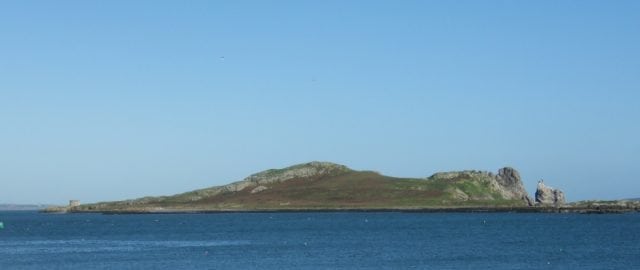- Created: August 28, 2012 10:32 am
- Updated: December 12, 2017 11:02 am
- Distance Instructions
- Distance 5 km
- Time 0 s
- Speed 0.0 km/h
- Min altitude 0 m
- Peak 15 m
- Climb 30 m
- Descent 31 m
Ireland's Eye is a small island off the coast of County Dublin, Ireland. It is a Special Protection Area but access is not restricted and is easily reached by regular tourist boats. In Celtic times the island was called Eria's Island. Eria was a woman's name and this became confused with Erin, derived from Éireann, the Irish name for Ireland. The Vikings substituted the word Island with Ey, their Norse equivalent, and so it became known as Erin's Ey and ultimately Ireland's Eye.
Ireland's Eye comprises the main island, a range of rocks and an islet called Thulla. The most spectacular feature is the huge freestanding rock called "the Stack", at the northeastern corner of the island. This 'Stack' has a large variety of seabirds, including guillemots, razorbills, fulmars and gulls. There is also a gannet colony on the Stack with a few hundred pairs breeding there. There is also large cormorant colony on the main island, and a few breeding pairs of puffins. Grey Seals are abundant in the sea around the island.
This 'Stack' has become a rock-climbing location, and has been climbed since the 1910s or before. Climbing does not take place during the seabird nesting season of April to July.
Gallery
Ireland’s Eye is a small island off the coast of County Dublin, Ireland. It is a Special Protection Area but access is not restricted and is easily reached by regular tourist boats. In Celtic times the island was called Eria’s Island. Eria was a woman’s name and this became confused with Erin, derived from Éireann, the Irish name for Ireland. The Vikings substituted the word Island with Ey, their Norse equivalent, and so it became known as Erin’s Ey and ultimately Ireland’s Eye.
Ireland’s Eye comprises the main island, a range of rocks and an islet called Thulla. The most spectacular feature is the huge freestanding rock called “the Stack”, at the northeastern corner of the island. This ‘Stack’ has a large variety of seabirds, including guillemots, razorbills, fulmars and gulls. There is also a gannet colony on the Stack with a few hundred pairs breeding there. There is also large cormorant colony on the main island, and a few breeding pairs of puffins. Grey Seals are abundant in the sea around the island.
This ‘Stack’ has become a rock-climbing location, and has been climbed since the 1910s or before. Climbing does not take place during the seabird nesting season of April to July.


